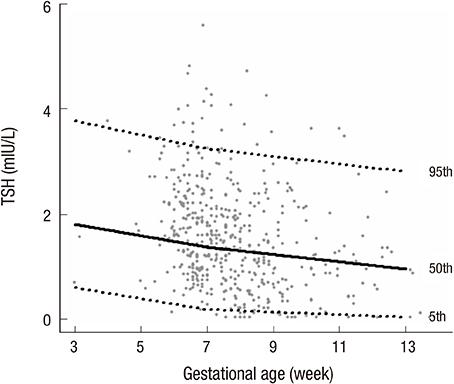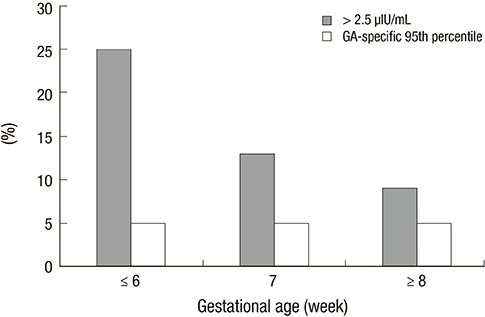J Korean Med Sci.
2015 Sep;30(9):1308-1312. 10.3346/jkms.2015.30.9.1308.
Gestational Age-specific Cut-off Values Are Needed for Diagnosis of Subclinical Hypothyroidism in Early Pregnancy
- Affiliations
-
- 1Department of Obstetrics and Gynecology, Seoul Metropolitan Government Seoul National University Boramae Medical Center, Seoul, Korea. smleemd@hanmail.net
- 2Department of Biostatistics, Seoul Metropolitan Government Seoul National University Boramae Medical Center, Seoul, Korea.
- KMID: 2344157
- DOI: http://doi.org/10.3346/jkms.2015.30.9.1308
Abstract
- During the first trimester of pregnancy, thyroid-stimulating hormone (TSH) >2.5 mIU/L has been suggested as the universal criterion for subclinical hypothyroidism. However, TSH levels change continuously during pregnancy, even in the first trimester. Therefore the use of a fixed cut-off value for TSH may result in a different diagnosis rate of subclinical hypothyroidism according to gestational age. The objective of this study was to obtain the normal reference range of TSH during the first trimester in Korean gravida and to determine the diagnosis rate of subclinical hypothyroidism using the fixed cut-off value (TSH >2.5 mIU/L). The study population consisted of pregnant women who were measured for TSH during the first trimester of pregnancy (n=492) and nonpregnant women (n=984). Median concentration of TSH in pregnant women was lower than in non-pregnant women. There was a continuous decrease of median TSH concentration during the first trimester of pregnancy (median TSH concentration: 1.82 mIU/L for 3+0 to 6+6 weeks; 1.53 mIU/L for 7+0 to 7+6 weeks; and 1.05 mIU/L for 8+0 to 13+6 weeks). Using the fixed cut-off value of TSH >2.5 mIU/L, the diagnosis rate of subclinical hypothyroidism decreased significantly according to the gestational age (GA) at TSH (25% in 3+0 to 6+6 weeks, 13% in 7+0 to 7+6 weeks, and 9% for 8+0 to 13+6 weeks, P<0.001), whereas the diagnosis rate was 5% in all GA with the use of a GA-specific cut-off value (P=0.995). Therefore, GA-specific criteria might be more appropriate for the diagnosis of subclinical hypothyroidism.
MeSH Terms
-
Adult
*Algorithms
Biomarkers/blood
Diagnosis, Computer-Assisted/*methods
*Diagnostic Techniques, Obstetrical and Gynecological
Female
*Gestational Age
Humans
Hypothyroidism/blood/*diagnosis
Pregnancy
Pregnancy Complications/blood/*diagnosis
Reproducibility of Results
Republic of Korea
Sensitivity and Specificity
Thyrotropin/*blood
Biomarkers
Thyrotropin
Figure
Cited by 1 articles
-
Maternal Thyroid Function during the First Trimester of Pregnancy in Korean Women
Hyung Wook Choi, You Jung Han, Dong Wook Kwak, So Young Park, Sung Hoon Kim, Hyun Koo Yoon, Chang Hoon Yim
Int J Thyroidol. 2017;10(1):36-41. doi: 10.11106/ijt.2017.10.1.36.
Reference
-
1. Lee YJ, Kim CH, Kwack JY, Ahn JW, Kim SH, Chae HD, Kang BM. Subclinical hypothyroidism diagnosed by thyrotropin-releasing hormone stimulation test in infertile women with basal thyroid-stimulating hormone levels of 2.5 to 5.0 mIU/L. Obstet Gynecol Sci. 2014; 57:507–512.2. Cleary-Goldman J, Malone FD, Lambert-Messerlian G, Sullivan L, Canick J, Porter TF, Luthy D, Gross S, Bianchi DW, D'Alton ME. Maternal thyroid hypofunction and pregnancy outcome. Obstet Gynecol. 2008; 112:85–92.3. Casey BM. Subclinical hypothyroidism and pregnancy. Obstet Gynecol Surv. 2006; 61:415–420. quiz 4234. Negro R, Schwartz A, Gismondi R, Tinelli A, Mangieri T, Stagnaro-Green A. Universal screening versus case finding for detection and treatment of thyroid hormonal dysfunction during pregnancy. J Clin Endocrinol Metab. 2010; 95:1699–1707.5. Sahu MT, Das V, Mittal S, Agarwal A, Sahu M. Overt and subclinical thyroid dysfunction among Indian pregnant women and its effect on maternal and fetal outcome. Arch Gynecol Obstet. 2010; 281:215–220.6. Wang S, Teng WP, Li JX, Wang WW, Shan ZY. Effects of maternal subclinical hypothyroidism on obstetrical outcomes during early pregnancy. J Endocrinol Invest. 2012; 35:322–325.7. Klein TA. Thyroid dysfunction in pregnancy: the basic science and clinical evidence surrounding the controversy in management. Obstet Gynecol. 2009; 113:1372. author reply 1372-3.8. Thung SF, Funai EF, Grobman WA. The cost-effectiveness of universal screening in pregnancy for subclinical hypothyroidism. Am J Obstet Gynecol. 2009; 200:267.e1–267.e7.9. Vila L, Velasco I, González S, Morales F, Sánchez E, Lailla JM, Martinez-Astorquiza T, Puig-Domingo M. Grupo de Trabajo de Trastornos por Deficiencia de Yodo y Disfunción Tiroidea de la Sociedad Española de Endocrinología y Nutrición. Detection of thyroid dysfunction in pregnant women: universal screening is justified. Endocrinol Nutr. 2012; 59:547–560.10. Dosiou C, Barnes J, Schwartz A, Negro R, Crapo L, Stagnaro-Green A. Cost-effectiveness of universal and risk-based screening for autoimmune thyroid disease in pregnant women. J Clin Endocrinol Metab. 2012; 97:1536–1546.11. Rosario PW, Purisch S. Thyroid dysfunction in pregnancy: definition of TSH cut-off should precede the decision of screening in low-risk pregnant women. Gynecol Endocrinol. 2011; 27:205–208.12. Haddow JE, Knight GJ, Palomaki GE, McClain MR, Pulkkinen AJ. The reference range and within-person variability of thyroid stimulating hormone during the first and second trimesters of pregnancy. J Med Screen. 2004; 11:170–174.13. Stricker R, Echenard M, Eberhart R, Chevailler MC, Perez V, Quinn FA, Stricker R. Evaluation of maternal thyroid function during pregnancy: the importance of using gestational age-specific reference intervals. Eur J Endocrinol. 2007; 157:509–514.14. Panesar NS, Li CY, Rogers MS. Reference intervals for thyroid hormones in pregnant Chinese women. Ann Clin Biochem. 2001; 38:329–332.15. Soldin OP, Soldin D, Sastoque M. Gestation-specific thyroxine and thyroid stimulating hormone levels in the United States and worldwide. Ther Drug Monit. 2007; 29:553–559.16. Bocos-Terraz JP, Izquierdo-Alvarez S, Bancalero-Flores JL, Alvarez-Lahuerta R, Aznar-Sauca A, Real-López E, Ibáñez-Marco R, Bocanegra-Garcia V, Rivera-Sánchez G. Thyroid hormones according to gestational age in pregnant Spanish women. BMC Res Notes. 2009; 2:237.17. Marwaha RK, Chopra S, Gopalakrishnan S, Sharma B, Kanwar RS, Sastry A, Singh S. Establishment of reference range for thyroid hormones in normal pregnant Indian women. BJOG. 2008; 115:602–606.18. Stagnaro-Green A, Abalovich M, Alexander E, Azizi F, Mestman J, Negro R, Nixon A, Pearce EN, Soldin OP, Sullivan S, et al. American Thyroid Association Taskforce on Thyroid Disease During Pregnancy and Postpartum. Guidelines of the American Thyroid Association for the diagnosis and management of thyroid disease during pregnancy and postpartum. Thyroid. 2011; 21:1081–1125.19. Li C, Shan Z, Mao J, Wang W, Xie X, Zhou W, Li C, Xu B, Bi L, Meng T, et al. Assessment of thyroid function during first-trimester pregnancy: what is the rational upper limit of serum TSH during the first trimester in Chinese pregnant women? J Clin Endocrinol Metab. 2014; 99:73–79.20. Moleti M, Trimarchi F, Vermiglio F. Thyroid physiology in pregnancy. Endocr Pract. 2014; 20:589–596.21. Kim JY, Kim KR. Dietary iodine intake and urinary iodine excretion in patients with thyroid diseases. Yonsei Med J. 2000; 41:22–28.22. Kim JY, Moon SJ, Kim KR, Sohn CY, Oh JJ. Dietary iodine intake and urinary iodine excretion in normal Korean adults. Yonsei Med J. 1998; 39:355–362.23. Hwang S, Lee EY, Lee WK, Shin DY, Lee EJ. Correlation between iodine intake and thyroid function in subjects with normal thyroid function. Biol Trace Elem Res. 2011; 143:1393–1397.24. Price A, Obel O, Cresswell J, Catch I, Rutter S, Barik S, Heller SR, Weetman AP. Comparison of thyroid function in pregnant and non-pregnant Asian and western Caucasian women. Clin Chim Acta. 2001; 308:91–98.25. Walker JA, Illions EH, Huddleston JF, Smallridge RC. Racial comparisons of thyroid function and autoimmunity during pregnancy and the postpartum period. Obstet Gynecol. 2005; 106:1365–1371.26. Blatt AJ, Nakamoto JM, Kaufman HW. National status of testing for hypothyroidism during pregnancy and postpartum. J Clin Endocrinol Metab. 2012; 97:777–784.27. Hollowell JG, Staehling NW, Flanders WD, Hannon WH, Gunter EW, Spencer CA, Braverman LE. Serum TSH, T(4), and thyroid antibodies in the United States population (1988 to 1994): National Health and Nutrition Examination Survey (NHANES III). J Clin Endocrinol Metab. 2002; 87:489–499.28. Han SM, Han JH, Park JA, Quinn FA, Park J, Oh E. Longitudinal evaluation of thyroid autoimmunity and function in pregnant Korean women. Clin Chem Lab Med. 2013; 51:2295–2301.29. Committee on Patient Safety and Quality Improvement. Committee on Professional Liability. ACOG Committee Opinion No. 381: Subclinical hypothyroidism in pregnancy. Obstet Gynecol. 2007; 110:959–960.30. Negro R, Stagnaro-Green A. Clinical aspects of hyperthyroidism, hypothyroidism, and thyroid screening in pregnancy. Endocr Pract. 2014; 20:597–607.31. Dhanwal DK, Prasad S, Agarwal AK, Dixit V, Banerjee AK. High prevalence of subclinical hypothyroidism during first trimester of pregnancy in North India. Indian J Endocrinol Metab. 2013; 17:281–284.
- Full Text Links
- Actions
-
Cited
- CITED
-
- Close
- Share
- Similar articles
-
- Subclinical Thyroid Dysfunction in the Elderly
- A Case of Hypothyroidism in Remission during Pregnancy
- Maternal Thyroid Function during the First Trimester of Pregnancy in Korean Women
- Depression in Patients with Subclinical Hypothyroidism: A Systematic Review and Meta-Analysis
- Prevalence and Risk Factors of Subclinical Thyroid Disease



